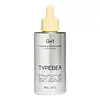What's inside
What's inside
 Key Ingredients
Key Ingredients

 Benefits
Benefits

 Concerns
Concerns

 Ingredients Side-by-side
Ingredients Side-by-side

Water
Skin ConditioningPropanediol
SolventAlcohol
AntimicrobialPolysorbate 20
EmulsifyingSodium Hydroxide
BufferingArginine
MaskingLactic Acid
BufferingCarbomer
Emulsion StabilisingDisodium EDTA
Parfum
MaskingButylene Glycol
HumectantPolyquaternium-7
Glycine Soja Germ Extract
EmollientTriticum Vulgare Germ Extract
Skin ConditioningGluconolactone
Skin ConditioningScutellaria Baicalensis Root Extract
AstringentCitrus Aurantium Bergamia Fruit Oil
MaskingPPG-26-Buteth-26
Skin ConditioningPEG-40 Hydrogenated Castor Oil
EmulsifyingCitrus Limon Peel Oil
MaskingCitrus Aurantium Dulcis Peel Oil
MaskingJuniperus Virginiana Oil
MaskingCalcium Gluconate
HumectantPinus Palustris Oil
MaskingApigenin
AntioxidantOleanolic Acid
Skin ConditioningBiotinoyl Tripeptide-1
Sodium Benzoate
MaskingPhenoxyethanol
PreservativeLimonene
PerfumingBenzyl Salicylate
PerfumingLinalool
PerfumingHydroxycitronellal
PerfumingWater, Propanediol, Alcohol, Polysorbate 20, Sodium Hydroxide, Arginine, Lactic Acid, Carbomer, Disodium EDTA, Parfum, Butylene Glycol, Polyquaternium-7, Glycine Soja Germ Extract, Triticum Vulgare Germ Extract, Gluconolactone, Scutellaria Baicalensis Root Extract, Citrus Aurantium Bergamia Fruit Oil, PPG-26-Buteth-26, PEG-40 Hydrogenated Castor Oil, Citrus Limon Peel Oil, Citrus Aurantium Dulcis Peel Oil, Juniperus Virginiana Oil, Calcium Gluconate, Pinus Palustris Oil, Apigenin, Oleanolic Acid, Biotinoyl Tripeptide-1, Sodium Benzoate, Phenoxyethanol, Limonene, Benzyl Salicylate, Linalool, Hydroxycitronellal
Water
Skin ConditioningBis-Aminopropyl Diglycol Dimaleate
Skin ConditioningPropylene Glycol
HumectantCetearyl Alcohol
EmollientBehentrimonium Methosulfate
Phenoxyethanol
PreservativeCetyl Alcohol
EmollientGlycerin
HumectantHydroxyethyl Ethylcellulose
EmulsifyingStearamidopropyl Dimethylamine
EmulsifyingQuaternium-91
Sodium Benzoate
MaskingCetrimonium Methosulfate
AntimicrobialCetrimonium Chloride
AntimicrobialParfum
MaskingTetrasodium EDTA
Polyquaternium-37
Benzyl Benzoate
AntimicrobialEtidronic Acid
Ascorbic Acid
AntioxidantPhytantriol
HumectantTocopheryl Acetate
AntioxidantAloe Barbadensis Leaf Juice
Skin ConditioningPanthenol
Skin ConditioningSimmondsia Chinensis Seed Oil
EmollientCitric Acid
BufferingPotassium Sorbate
PreservativeWater, Bis-Aminopropyl Diglycol Dimaleate, Propylene Glycol, Cetearyl Alcohol, Behentrimonium Methosulfate, Phenoxyethanol, Cetyl Alcohol, Glycerin, Hydroxyethyl Ethylcellulose, Stearamidopropyl Dimethylamine, Quaternium-91, Sodium Benzoate, Cetrimonium Methosulfate, Cetrimonium Chloride, Parfum, Tetrasodium EDTA, Polyquaternium-37, Benzyl Benzoate, Etidronic Acid, Ascorbic Acid, Phytantriol, Tocopheryl Acetate, Aloe Barbadensis Leaf Juice, Panthenol, Simmondsia Chinensis Seed Oil, Citric Acid, Potassium Sorbate
 Reviews
Reviews

Ingredients Explained
These ingredients are found in both products.
Ingredients higher up in an ingredient list are typically present in a larger amount.
Parfum is a catch-all term for an ingredient or more that is used to give a scent to products.
Also called "fragrance", this ingredient can be a blend of hundreds of chemicals or plant oils. This means every product with "fragrance" or "parfum" in the ingredients list is a different mixture.
For instance, Habanolide is a proprietary trade name for a specific aroma chemical. When used as a fragrance ingredient in cosmetics, most aroma chemicals fall under the broad labeling category of “FRAGRANCE” or “PARFUM” according to EU and US regulations.
The term 'parfum' or 'fragrance' is not regulated in many countries. In many cases, it is up to the brand to define this term.
For instance, many brands choose to label themselves as "fragrance-free" because they are not using synthetic fragrances. However, their products may still contain ingredients such as essential oils that are considered a fragrance by INCI standards.
One example is Calendula flower extract. Calendula is an essential oil that still imparts a scent or 'fragrance'.
Depending on the blend, the ingredients in the mixture can cause allergies and sensitivities on the skin. Some ingredients that are known EU allergens include linalool and citronellol.
Parfum can also be used to mask or cover an unpleasant scent.
The bottom line is: not all fragrances/parfum/ingredients are created equally. If you are worried about fragrances, we recommend taking a closer look at an ingredient. And of course, we always recommend speaking with a professional.
Learn more about ParfumPhenoxyethanol is a preservative that has germicide, antimicrobial, and aromatic properties. Studies show that phenoxyethanol can prevent microbial growth. By itself, it has a scent that is similar to that of a rose.
It's often used in formulations along with Caprylyl Glycol to preserve the shelf life of products.
Sodium Benzoate is a preservative. It's used in both cosmetic and food products to inhibit the growth of mold and bacteria. It is typically produced synthetically.
Both the US FDA and EU Health Committee have approved the use of sodium benzoate. In the US, levels of 0.1% (of the total product) are allowed.
Sodium benzoate works as a preservative by inhibiting the growth of bacteria inside of cells. It prevents the cell from fermenting a type of sugar using an enzyme called phosphofructokinase.
It is the salt of benzoic acid. Foods containing sodium benzoate include soda, salad dressings, condiments, fruit juices, wines, and snack foods.
Studies for using ascorbic acid and sodium benzoate in cosmetics are lacking, especially in skincare routines with multiple steps.
We always recommend speaking with a professional, such as a dermatologist, if you have any concerns.
Learn more about Sodium BenzoateWater. It's the most common cosmetic ingredient of all. You'll usually see it at the top of ingredient lists, meaning that it makes up the largest part of the product.
So why is it so popular? Water most often acts as a solvent - this means that it helps dissolve other ingredients into the formulation.
You'll also recognize water as that liquid we all need to stay alive. If you see this, drink a glass of water. Stay hydrated!
Learn more about Water